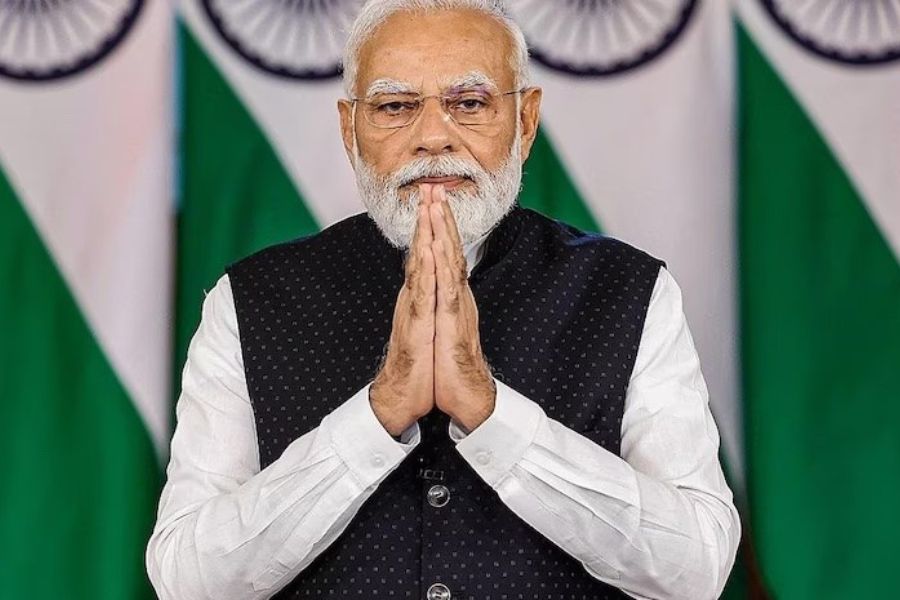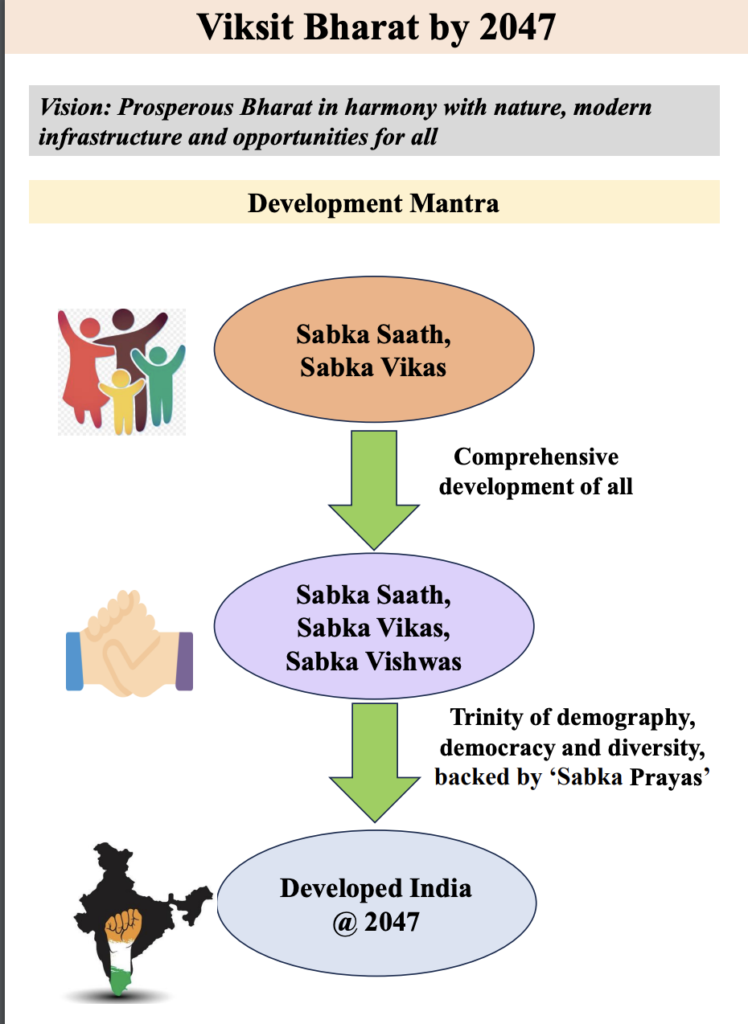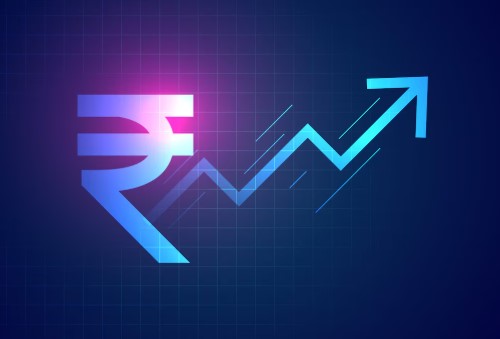Table of Contents
PM Modi’s Viksit Bharat vision aims to elevate India into a $30 trillion economy by 2047. How will this ambitious plan unfold and impact every Indian?

Source: Business Standard
On 11 December 2023, Prime Minister Narendra Modi launched ‘Viksit Bharat@2047‘ with a clear vision for India’s future. In the following year’s budget, Finance Minister Nirmala Sitharaman outlined steps to achieve this vision by the centenary year of India’s independence.
What does ‘Viksit Bharat’ involve, and what does it mean for India’s economy and the stock market? Read on for more insights.
What is Viksit Bharat?
“Viksit Bharat” translates to “Developed India,” and it is the ambitious vision of India’s Prime Minister, Narendra Modi. The goal is to transform India into a developed nation with a $30 trillion economy by 2047, which marks the 100th anniversary of India’s independence.
The core idea is to create a prosperous India that lives in harmony with nature and where modern infrastructure and equal opportunities are accessible to all its citizens.
The framework comprises a few key philosophies:
- “Sabka Saath” – Together with everyone
- “Sabka Vikas” – Development for all
- “Sabka Vishwas” – Gaining everyone’s trust
These are supported by “Sabka Prayas,” which means everyone’s efforts. Each individual’s contribution is valued towards the national goal in this collective call for action.

Source: India Budget
The vision aims to harness India’s demographic diversity, uphold democratic values, and celebrate cultural diversity. The ultimate goal is to see India emerge as a developed country by 2047. It encompasses not only economic growth but social cohesion, environmental sustainability, and an inclusive society.
Key objectives of Viksit Bharat
At its core, Viksit Bharat focuses on many key goals. They are:
- Economic empowerment: Viksit Bharat’s core ambition is to create a strong economy. It must be inclusive and offer many opportunities for all citizens. It includes fostering a climate good for investment. It also includes promoting entrepreneurship and encouraging the growth of MSMEs, which are integral parts of the national economy.
- Infrastructure development: Building top-notch infrastructure that guarantees sustainable growth and improves people’s quality of life is a key component of this aim. To improve daily living and accessibility for everybody, this includes modernising roads, trains, digital connectivity, and urban infrastructure.
- Social inclusion and welfare: Viksit Bharat aims to bridge divides between various societal segments. It puts a high priority on the welfare of all its people. The goal of initiatives on healthcare, education, gender equality, and financial inclusion is to ensure that all people benefit from the country’s economic growth.
- Environmental sustainability: The effort also aims to make India greener and cleaner. Achieving a balance between development and conservation requires making efforts to increase the use of renewable energy, save water, and improve urban green spaces.
- Technological advancement: Another important goal is to use technology to enhance service delivery and streamline governance. Viksit Bharat uses digital platforms for public services and welfare. It aims to improve access to government services, reduce corruption, and increase transparency.
Pillars of Viksit Bharat
The focus of Viksit Bharat is on empowering the core segments of society through its pillars.

Source: PIB
- The poor (Garib): With schemes like Direct Benefit Transfer (DBT) and PM-SANNidhi, multidimensional poverty is tackled, alongside credit facilities for street vendors enhancing livelihoods.
- The youth (Yuva): Training 1.4 crore individuals under Skill India and sanctioning 43 crore loans via PM Mudra Yojana underscores a commitment to skill and entrepreneurship.
- Farmers (Annadata): PM-KISAN ensures direct financial support, while crop insurance and eNAM integration safeguard and streamline agriculture.
Women (Mahilayen): A surge in education enrolment and support for business women through Mudra loans mark significant strides in women’s empowerment
Impact on the economy and the stock market
The equity market’s growth mirrors India’s ambitious development targets. The stock market’s contribution to Viksit Bharat aims to increase market capitalisation and deepen markets, including commodities and debt.
The NSE’s substantial trade volumes signal robust market dynamics, supporting millions of jobs. The surge in IPOs, including over 65 mainboard companies in recent times, indicates heightened investor confidence and a fertile ground for new ventures.
Digitalization and policy reforms have broadened investor participation. BSE officials highlight that technological advancements have tripled investor numbers, playing a critical role in financial literacy and inclusion. This expansion is a testament to India’s commitment to integrating financial services into the broader economy.
India’s journey towards a $10 trillion market cap by 2030, as predicted by Jefferies, is supported by a consistent growth trajectory in GDP and market returns. This progress positions India to leapfrog into the league of global economic superpowers, with the stock market being a cornerstone of this ascent.
How to register for Viksit Bharat?
To contribute to the process of achieving “Viksit Bharat 2047,” the government extends an invitation to all individuals to submit their creative ideas. Here’s how to sign up and make a contribution:
Step 1: Open the MyGov.in website.
Step 2: Find and select the option “Share Your Ideas for Viksit Bharat.”
Step 3: After entering your name and email address or mobile number, you must click the “LogIn with OTP” button.
Step 4: Enter your OTP and click “Submit” after receiving it by email or mobile device.
Step 5: Select “Student” or “Non-Student” and complete the necessary forms. These consist of your contact details, full name, gender, age, and level of education or occupation. Verify your information, then continue.
Step 6: Choose the topics that interest you and then express your thoughts on how India might become a developed country by 2047. Your recommendations can address a range of topics, including better governance, social progress, environmental sustainability, and economic development. When prepared, select “Submit.”
By incorporating a variety of viewpoints into Viksit Bharat, this effort hopes to create a developed, inclusive, and sustainable country by the year 2047. Your suggestions might open the door to revolutionary adjustments that could significantly accelerate India’s progress.
Conclusion
India’s path to becoming a developed country by 2047 is being paved by Viksit Bharat. This vision aims to transform India’s worldwide image by showcasing its comprehensive approach to economic growth, social inclusion, environmental sustainability, and technological advancement, positioning the country as a model of prosperity and inclusivity.
DISCLAIMER: This article is not meant to be giving financial advice. Please seek a registered financial advisor for any investments.
- Nifty & Sensex — how to get live updates quickly - November 4, 2025
- Not Diamonds, Gold is the Indian Woman’s Best Friend Forever - October 30, 2025
- IdeaForge, Paras Defence, BEL, HAL – Defence & Drone Push Offers Compelling Narratives - October 7, 2025





